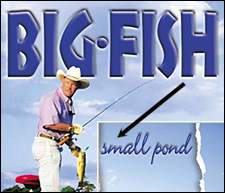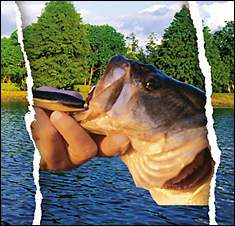|

Whether it's big bucks or big bass your're after, a little management goes a long way. Here's how to get started.
By Larry Bozka
At age 31, James
"Macky" McIntyre has probably forgotten more about managing
bass lakes than most avid bassers will ever know. A native Texan
who grew up in the Houston area, he received his degree from Texas
A&M University's Wildlife & Fishery Department in Aquaculture
and Fishery Management in 1990. Immediately thereafter, he went
to work building intensive recirculating systems for a redfish
production facility in Bacliff that's now known as "Harvest
Fresh Reds."
But he'd yet
to move into the niche he really wanted to pursue-lake management-and
he didn't waste any time making it happen.
"When
a position at Bieri Lakes opened up in the fall of 1991, I went
for it," McIntyre recalls. He's been managing the scenic
Brazoria County bass haven ever since, and has turned the membership-only
"country club bass fishing" facility near Angleton into
a first-class operation.
After conducting
lake management consultations on an on-and-off basis for six years,
McIntyre established Lake Pro Pond and Lake Management Services
in early 1997. "I was getting a lot of requests for help,"
he says, "and wanted to get more involved with the stocking
and treatment of other lakes. We also specialize in the stocking
and management of urban developments for property associations-assessing
the vegetation and structure make-up of the lakes as well as installing
floating aeration systems for enhanced water circulation and,
in general, improving the productivity and aesthetics of the recreational
fishing."
Basically,
McIntyre and others of his ilk start working on one of two scenarios:
designing and stocking brand-new ponds, and creating management
programs for water bodies that already exist. As a general rule,
we're talking here about lakes ranging in size from 2 to 5 acres.
Managing an existing pond
 Say you have
an old lake on the family place, and you don't really have a clue
as to how many fish of what species live in its waters. "What
do you do?" I ask McIntyre. Say you have
an old lake on the family place, and you don't really have a clue
as to how many fish of what species live in its waters. "What
do you do?" I ask McIntyre.
"You have
three basic options," he responds. "First comes renovation,
when you kill everything out and start over. Second, you can use
harvest manipulation, through which you take out your smaller
bass-less than 12 inches long. Or you can implement a supplemental
corrective stocking-add more bluegills and shad to provide a variety
of forage or perhaps add more bass fingerlings.
"We'll
go in and talk with the landowner to get whatever information
we can regarding past stockings, what the owner is catching and
what his or her long-term goals are. Does he want to catch a lot
of bass, or does he want to gear the program for the selective
creation of fewer but substantially bigger fish?
"With
that determined," he continues, "we sample the lake.
We might use 'shoreline sampling,' a procedure of seining along
the shores which is usually done in June. This method is primarily
intended to determine if you're getting any recruitment of bass
or bluegill fingerlings. We also do lake samplings through electrofishing.
We take out a boat rigged up with a shocker box powered by an
electric generator. It doesn't hurt the fish; it just temporarily
stuns them so that we can net 'em up, identify the various species,
put 'em on the boat and take length and weight measurements. That
information tells us what needs to be done for corrective stocking
in accordance with the pond owner's goals."
Some owners
have reservations about the effect of electroshocking on the fish,
but, McIntyre explains, it's an unwarranted concern when conducted
by fishery managers with both sufficient know-how and the proper
equipment. "The technology has really advanced," he
points out. "Used to be, if you double-shocked fish and then
threw them back in, you could break their backs because they're
still in a rigid state. But with the Coffelt shockers we use
it is as safe as it gets." (They're not cheap, but if you
would like to own your own Coffelt unit you can contact the company
at 520-774-8829.)
"We then
determine relative weights," McIntyre continues. "The
actual weight of the fish is divided by a standard, with the standard
on top and the actual on the bottom. The figure is then multiplied
by 100, which gives us a percentage. If the standard weight for
a given fish of that size is 5 pounds, you want that fish to rank
100 percent. If the fish is less than that weight, say 85 percent,
we enact management procedures to bring the bass up to the standard.
"Two primary
factors enter the picture at this point-the forage base and the
habitat. Without sufficient vegetation and structure, there is
no place for the forage fish to hide to escape predation. A lot
of ponds, over years in which the vegetation aggressively develops,
actually contain too much habitat. Vegetation can ultimately
cover the entire impoundment, and since a large percentage of
ponds and tanks tend to be shallow, so much grass grows that it
can actually over-protect the forage fish-of which," he adds,
"are most often native bluegills. When that happens, it can
have a seriously adverse effect on the resident bass."
Aside from
bluegills, McIntyre also introduces other forage species into
lakes he manages-mostly redear sunfish and shad. Some managers
opt for coppernose bluegills imported from Florida, but McIntyre
isn't a big fan of them because of the simple fact that they do
not reproduce in near as prolific a manner as native bluegills.
Following the
determination of relative weights, McIntyre then determines proportional
stock densities which compare the ratio of bass to bluegills.
"We compare 'catchable' bass-say, fish over 12 inches in
length-to the larger bluegills" he says. "The decisions
we make in regard to corrective stocking are based on that comparative
relationship-whether to add more bluegills, either small or large,
whether to harvest bass due to overpopulation or whether to stock
more bass in order to counter an overpopulation of bluegills or
an overharvest of bass."
continued
page 1 / page 2
| 




